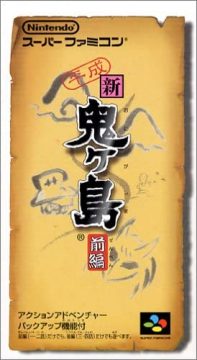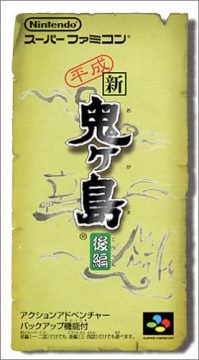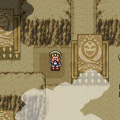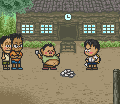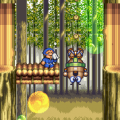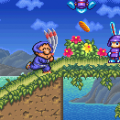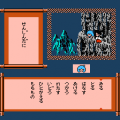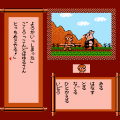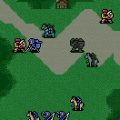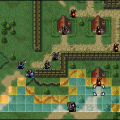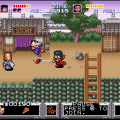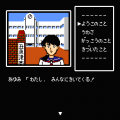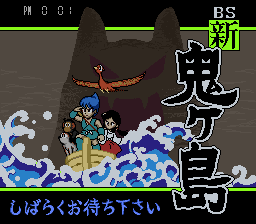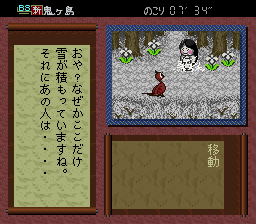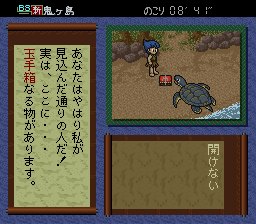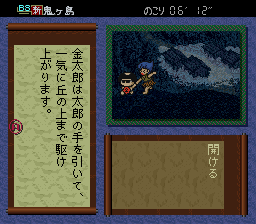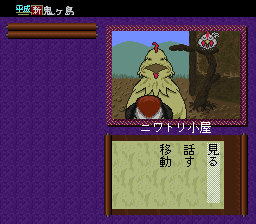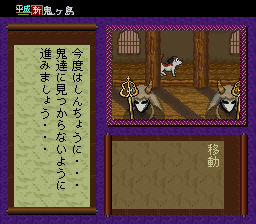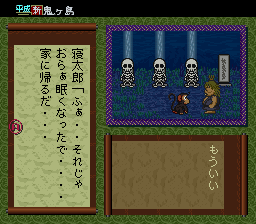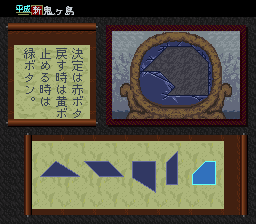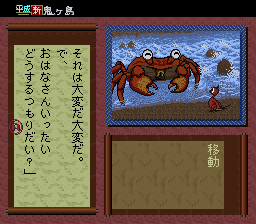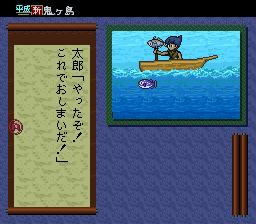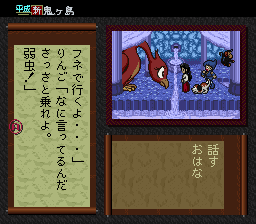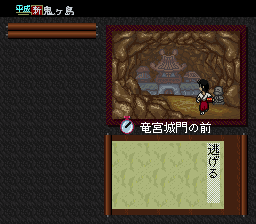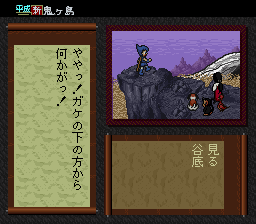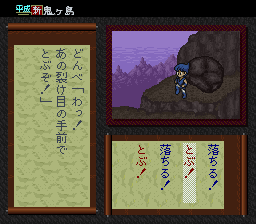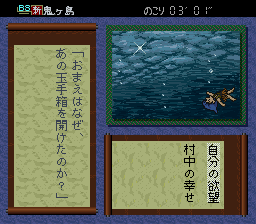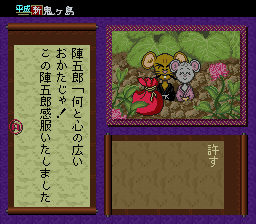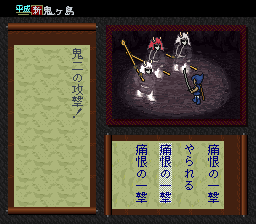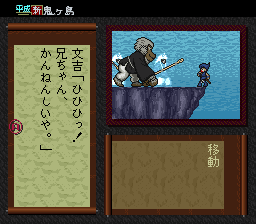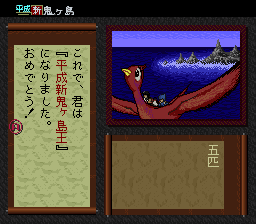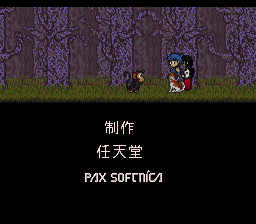- Shin Onigashima
- Yuuyuuki
- BS Shin Onigashima
At the end of the Famicom era, Nintendo mothballed its two first party adventure game series Famicom Mukashibanashi and Famicom Detective Club with no apparent signs of intending to revive them on their new generation of consoles. Yuuyuuki (1989) would have been the last game of these franchises, had it not been for an unusual 1995 Japan-only satellite broadcast, games-as-a-service peripheral for the Super Famicom called the Satellaview. The add-on allowed paying subscribers to download content such as games, music and magazines to a special memory cartridge through the, for English-speakers, slightly unfortunately named BS Network (“Broadcast Satellite”). Apart from the fact of how far ahead of its time the Satellaview was, the probably most fascinating aspect of the service was the so called SoundLink games, where special Satellaview versions of games were co-broadcast with satellite radio audio that enabled CD quality music and voice-acting to play at set intervals during the game. The trade-off of doing this were that games were only accessible at pre-scheduled time slots, and that the gameplay was tied to a timer in order to make sure that the game was properly synced to the satellite audio (for more information on Soundlink games and their state of preservation, see e.g. the BS Tantei Club article). Following the success and popularity of the first SoundLink game, BS Zelda no Densetsu (1995; a time-attack re-imagining of the first The Legend of Zelda), a number of old and new Nintendo properties got their own Satallaview versions, including Famicom Mukashibanashi: Shin Onigashima.
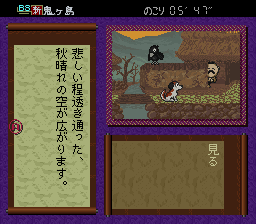
BS Shin Onigashima was co-developed by PaxSoftnica and Nintendo and was originally broadcast in October 1996 (and later re-broadcast twice after popular vote). Like many other SoundLink games it was divided in four parts, with one new episode made available each week across the duration of a month. The game is a “gaiden” (side-story) sequel to the original Famicom Disk System Shin Onigashima, and follows the lives of the three animal companions from the tale of Momotarou before they met Donbe and Hikari, the main characters from the FDS game. Each animal stars in their own episode: Ringo the dog in the first episode, Matsunoke the monkey in the second and Ohana the pheasant in the third. The third episode also features a section starring Tarou from the tale of UrashimaTarou that serves to expand on some of the late game story events of the original game. The fourth and final chapter is a remake of the two last chapters of FDS Shin Onigashima in which the party arrive at Oni Island and fight the dragon who has been stealing human souls. Each episode consists of three sub-episodes where the animals are contacted by the deity Hinoe-sama in their dreams and are led towards their inevitable meeting with Donbe and Hikari. Ringo and Matsunoke get three sub-episodes each, but Ohana only gets two in order to make room for Tarou’s single sub-episode.
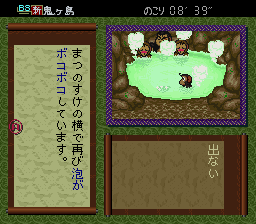
In a good effort to tie the big narrative together, the parallel events from FDS Shin Onigashima are summarized by series’ narrator Ittai-san in cutscenes in-between sub-episodes. This is where the SoundLink functions come into play, as Ittai-san’s narration is fully voiced by actor Ichirou Nagai. Each sub-episode gives the player 13-16 minutes to try to solve as much of the section as possible (episode four makes an exception from this, giving the player a total of 38 minutes to complete all its sub-episodes). A timer in the top right corner indicates the remaining time, and when the time is up the game skips to the next section irrespective of the player’s progress. At pre-determined times, Ittai-san interjects with comments and clues, but since this was done via Satellite audio, it was not connected to player actions. The gameplay section is followed by a summary in text and voice (Megumi Morita) of the sub-episode you just played. The parts of the sub-episode that you missed or did not have time to solve are X:ed out in the text summary, enticing you to replay the game and try to do better. The voice-over, however, does not censor the missing words, and thus function as clues for new replays, and as a way to ensure that players learn the important details they need to know in order to follow along with the next sub-episode.
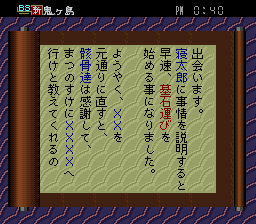
The parts of the sub-episodes that the player did not solve are censored by X:s in the post-game story summary; colored kanji represent the parts that were encountered/solved.
Just like in Yuuyuuki, the regular menu-based adventuring is sometimes mixed up with small mini-games where the player takes direct control of the action. There are about 1-2 mini-games per episode in BS Shin Onigashima, including sneaking past oni guards, helping skeletons reconstruct their missing graves, racing down a river while being chased by a witch and avoiding obstacles and a small turn-based battle system. At the end of the fourth episode there is a 40 question quiz about the game, and if you clear them all you will be crowned “King of Shin Onigashima” (a similar quiz was hidden in one of the last scenes of the FDS version, but here it triggers automatically). They typically do a good job of breaking up the regular menu-based gameplay, but are programmed with very small margins on the detection boxes and require quite some practice to beat. In most areas of the game the player also has to walk the character themselves rather than selecting from a menu which location to instantly go to (a system first introduced in the previous PaxSoftnica game Time Twist).
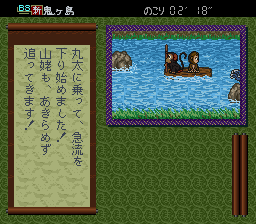
The Satellite broadcast music is excellent and features new tunes as well as orchestrated versions of the FDS songs. Sadly, they are only available on the VHS recordings of the original Satallaview broadcasts, and the dumped roms only contain the game and not the Satellite audio. This was the first ADV game on the Satellaview, and although the way they solved the audio-sync challenge by using timed sub-episodes is interesting, this version of the game is not very fun to play. The timer makes playing the game stressful and is set to a very tight deadline: even if you know exactly what commands to enter, it is likely that you will finish each sub-chapter with only 1-2 minutes left on the timer, which means that there is little room for mistakes. This is only made worse by the many sections with player-controlled movement, and this type of traversal eats up a majority of the allotted time. There are also a few scenes in which you can die (mainly the mini-games), and while you only have to restart from the last scene you were in, dying even once is likely to rob you of the chance to fully complete the section. The Famicom Detective Club game on the Satellaview, BS Tantei Club (1997), seem to have learned from this experience and approached the time-limited gameplay slightly different: there were no sub-episodes and no player-controlled movement between scenes, so when the forced advancing occurred the player only lost the chance to gain more details about the scene, but never missed out on the other scenes.
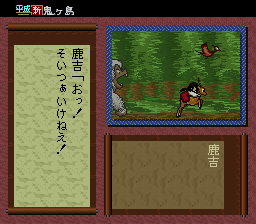
Unlike most other SoundLink games, the game was later ported to a standard cartridge with the SoundLink audio converted to text and regular SFC chip music; this version was named Heisei Shin Onigashima after its release date in the Japanese Imperial Calendar (FDS Shin Onigashima was released in the last years of the Showa era, and when the SFC game was released ten years later, there was a new Emperor and thus a new era: Heisei). It was initially sold for the Nintendo Power download kiosk, and later also as a boxed commercial game. In reference to how the FDS original came on two disks, the game was released on two carts: Zenpen (chapters 1-2) and Kouhen (chapters 3-4). Unlike the FDS version, the Kouhen cart can be started without first having played Zenpen. Apart from the novelty factor, there seems to be little reason to split the game on two carts, unless it actually was cheaper to produce two standard carts than one with expanded ROM capacity. The boxed carts were sold at 3,800 yen each, and while the Nintendo Power version was cheaper per part (2,100 yen) it required the user to own a memory cart to store the games on, which sold for an additional ¥3,980. In comparison, a large (single-cart) RPG such as FFVI cost 11,400 yen at release.
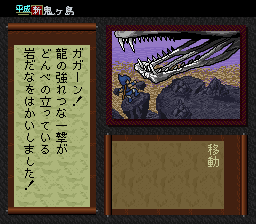
Heisei Shin Onigashima is in many ways a director’s cut of the game and no doubt the version to play today. The single most important feature is that the timer has been removed, meaning that the game progression is completely up to the player and not a pre-programmed deadline. This change alone solves many of the issues of BS Shin Onigashima, and gives the game a well-deserved chance to shine and show all of its content. But apart from the omission of the timer, there are actually quite a few other changes made to the game. The order of some scenes have been changed, some graphics have been redrawn or been put under a Yoshi’s Island-style crayon-filter and in some scenes the menu options have new phasing (e.g. specific verbs like “investigate”, instead of the catch-all “look at”). Other scenes and puzzles have been completely redesigned and a lot more mini-games have been added. However, now that the player can play the game at their own leisure, it becomes clear that some of the sub-episodes feel a little flat and generic compared to previous adventures of the Famicom Mukashibanashi series. The content improves quite a bit as the episodes progress, but it is telling that the best episode is the final one: i.e. the remake of the original Shin Onigashima’s end-game. The idea to focus on the animal companions is a nice addition to the series, but one that ultimately suffers from the issue of making a prequel to a grand adventure: things never get as exciting or impactful as Donbe and Hikari’s story. It is clear that a lot of effort went into making the game and its high number of beautifully rendered scenes, and it is therefore more than a little unfortunate that the siblings’ story, which is only presented in cutscenes up until the last episode, is more interesting than the main content of the game.
Screenshot comparisons and changes between BS and Heisei Shin Onigashima
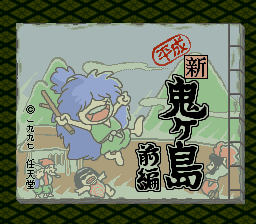

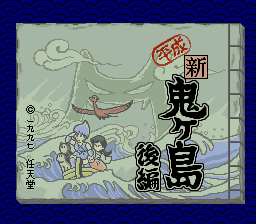

All episodes of BS Shin Onigashima used the same title screen (see top of page), but Heisei got a new one for Zenpen. They were all reinterpretations of the original FDS covers
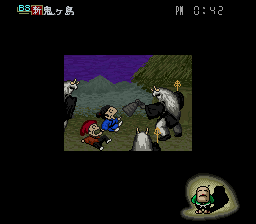
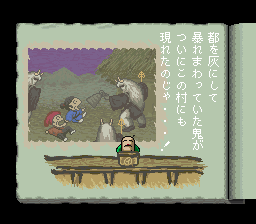
The BS version’s cutscenes were updated in Heisei with a crayon-style filter and the voice-over content replaced with text.
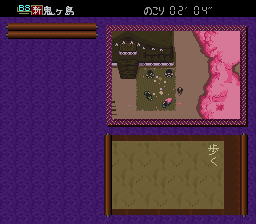
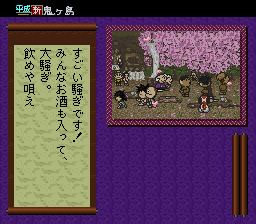
The ending of Ringo’s first sub-episode was redrawn from an overhead-view (BS) to a side-view (Heisei)
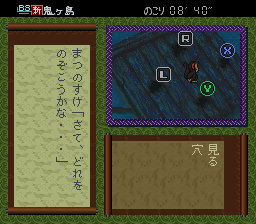
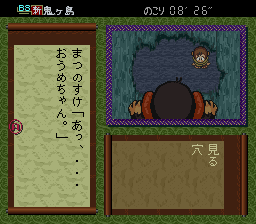
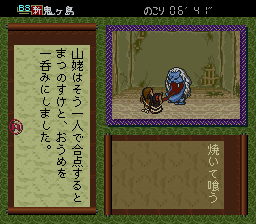
Matsunoke’s third and final sub-episode in which he rescues his love interest from a forest-witch was highly altered and expanded on in Heisei. Above: examples of scenes from BS Shin Onigashima that were removed in Heisei.
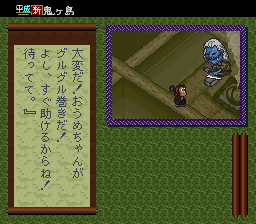
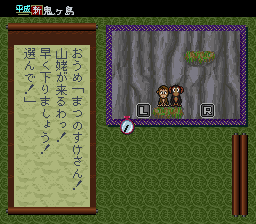
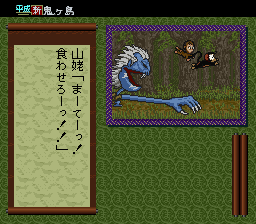
A few of Matsunoke’s reworked scenes in Heisei. The new content involved two new mini-games and a completely different take on the events inside the witch’s hut.
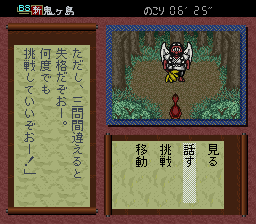
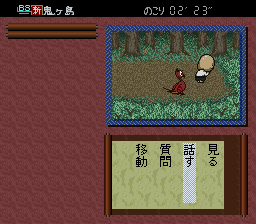
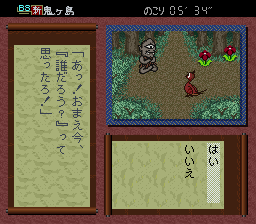
Ohana’s second sub-episode in which she searches for Princess Otohime’s magical necklace was also drastically changed in Heisei. Above: some of the scenes in BS Shin Onigashima that were removed in Heisei.
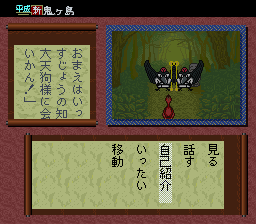
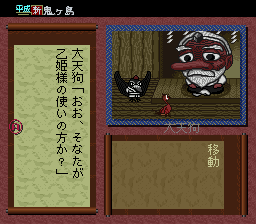
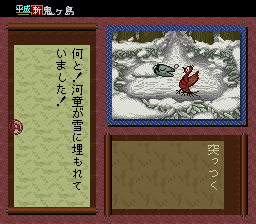
Examples of Ohana’s new scenes in Heisei.
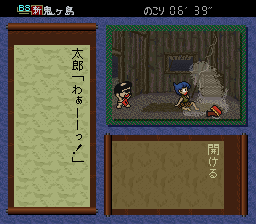
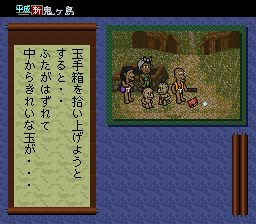
Urashima Tarou’s section in BS Shin Onigashima show him opening the forbidden box out of his own curiosity (only to be rescued by Kintarou), but in Heisei it is opened by mistake when he accidentally drops it on the ground, which serves to take a little of the blame away from him.
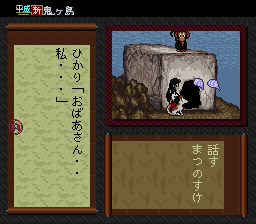
![C:\Users\Daniel\Dropbox\Private backup (non-work related)\HG101\Famicom Mukashibanashi\03 -BS and Heisei Shin Onigashima\Famicom Mukashibanashi - Shin Onigashima [Merged, works in fceux230]-487.png](http://www.hardcoregaming101.net/wp-content/uploads/2021/12/c-users-daniel-dropbox-private-backup-non-work-r-19.png)
The fourth episode of the game is a remake of the final two chapters of the FDS original. While many scenes in the chapter are brand new additions, other scenes have been closely replicated. The BS-X and cart version are identical for this episode.
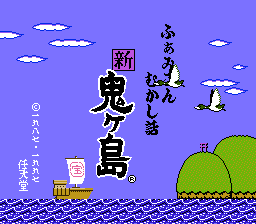
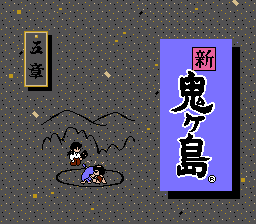
The original FDS disks are unlocked after beating Heisei (the FDS Zenpen disk is available on the Heisei Zenpen cart and the FDS Kouhen disk on the Heisei Kouhencart). The only known differences from the FDS version is that a sumo wrestling scene between Donbe and Kintarou has been added at the start of the game, as well as the year of Heisei’s release in kanji (一九九七, meaning 1997).
References and further reading
VHS recordings of the original BS Shin Onigashima broadcasts from the 1990s. The link is for the first episode of the game, but all four episodes are available on the channel (Cabbusses’s Retro Obscurities). The NND of the video titles refer to the Japanese video site NicoNicoDouga.
https://www.youtube.com/watch?v=SyB91bYZtD8
Annotated guide for the Heisei version of the game
https://nindb.net/snes/heisei-shin-onigashima/guide1.html
The official 1997 Nintendo web page for Heisei Shin Onigashima, still online in 2021.
https://www.nintendo.co.jp/n02/shvc/ao4j/index.html
Staff credits for the BS Shin Onigashima version
http://bsx.seesaa.net/article/32316479.html
PaxSoftnica would go on to design one more ADV together with Nintendo: Famicom Bunko: Hajimari no Mori (1999).
http://www.hardcoregaming101.net/famicom-bunko-hajimari-no-mori/
